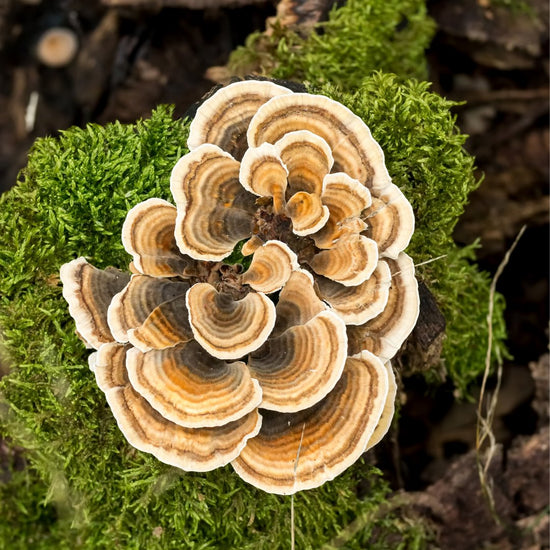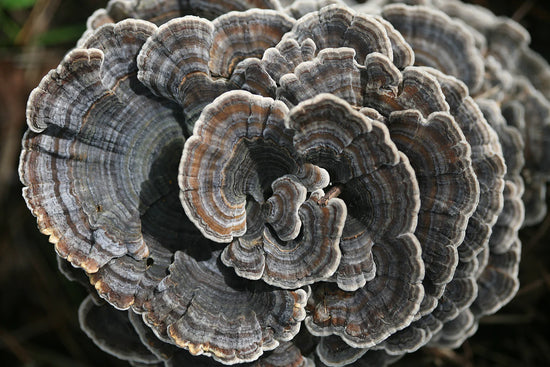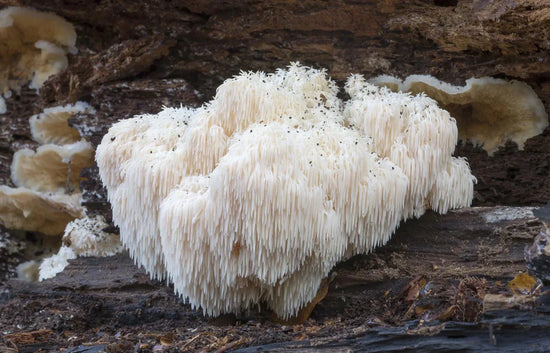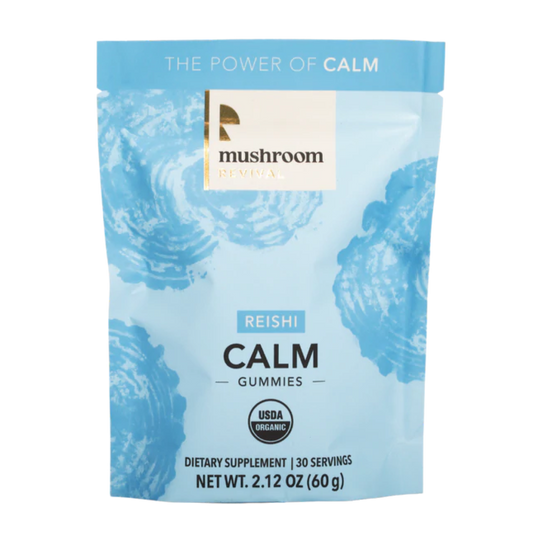Demystifying the Fly Agaric 🍄 feat. Kevin Feeney, PhD
What makes the Fly Agaric the most iconic mushroom in the world? And why, despite its prominence, is it so poorly understood? Today on the show we are starting from the ground up to demystify the reputations of this mushroom with cultural anthropologist, Kevin Feeney, PhD. In his book "Fly Agaric: A Compendium of History, Pharmacology, Mythology, & Exploration" Kevin has elaborated on nearly every aspect of this mushroom, finally providing comprehensive literature on this species. We take these 450 pages and present bite-sized answers to all of your Fly Agaric questions.
Topics Covered:
- Ecology, geography, and mycology of Amanita muscaria
- The etymology of The Fly Agaric
- Prevalence in pop culture and pedestrian use amanita imagery
- Pharmacology, especially muscimol & ibotenic acid
- Soma, and the parallels of this sacred drink and the Fly Agaric
- Motifs and archeological evidence of amanita muscaria in ritual use
- Gordon Wasson's influence on interpreting Soma, Viking Berserkers and more

Show notes:
Kevin's Book "Fly Agaric: A Compendium of History, Pharmacology, Mythology & Exploration" : https://www.amazon.com/Fly-Agaric-Compendium-Pharmacology-Exploration/dp/0578714426
Sacred Plants of the Americas Conference: https://chacruna.net/sacred-plants-americas-2-conference/
Kevin's profile: https://www.researchgate.net/profile/Kevin-Feeney
Soma: https://www.britannica.com/topic/soma-Hinduism
Amanita muscaria profile: http://www.mushroomexpert.com/amanita_muscaria_muscaria.html
Gordon Wasson's Soma Report: https://www.amazon.com/Soma-Mushroom-Immortality-Ethno-Mycological-Studies/dp/0156838001
TRANSCRIPT
You're listening to the mushroom revival podcast.
So what have you got for us today? Lera
Lera 0:12
Oh, only a report on the most iconic mushroom in the world. Any guesses?
Alex 0:18
Magic mushrooms, I'm guessing? Button mushrooms.
Lera 0:20
I'll give you a hint. It's got a red cap with little white dots
Alex 0:24
Fly Agaric!
Lera 0:25
Yes.
Alex 0:26
AKA Amanita muscaria the Mario mushroom. Soma, the Santa Claus mushroom. The mushroom emoji on your phone. Yeah.
Lera 0:35
All the above!
Alex 0:36
Yeah. Wow. It is one of the most iconic mushrooms in the world. You can see this mushroom on postcards on clothing, even popularized by Super Mario, but I've always wondered
Lera 0:49
why. It's a great question Alex and I've wondered this myself, but guess what? Today we have an expert by the name of Mr. Kevin Feeney who wrote a 450 page book with over two dozen contributors all about this mushroom. It's called fly agaric, a compendium of history, pharmacology, mythology and exploration.
Alex 1:15
So my lovely lovely listeners sit back on your toadstools. Today on the show we are going to demystify the iconic fly agaric mushroom, its history, culture, ecology and yes, psychoactive properties. We might even cover how to prepare this mushroom as an afternoon snack.
Lera 1:43
As a practicing mycologist I like to say I first encountered this mushroom in the forest, but honestly, it was super mario.
Alex 1:50
For me it was Mario Kart. Well, none of us are truly new to this mushroom is still a stranger in many ways. So why don't we start over with a Fly Agaric by visiting its mycology.
Lera 2:03
So this enigmatic mushroom begins as a kind of egg. The mycelium or vegetative state of the fungus will form a grape sized whitish mass just above the soil. And inside, if you did a longitudinal cut, you would see a baby mushroom. And this eggshell is known as the universal veil. It's a temporary protective membrane for the young mushroom. And as it swells the mushroom freaks to the top and emerges as the familiar cap and stem, those little white dots or words or leftover bits of that veil, and the little skirt you see just below the cap is a membrane that protects the gills until the mushroom matures and expands. And they can grow quite large up to a foot tall and the cap can be about the size of a dinner plate and
Alex 2:48
underneath the soil is just as interesting. So Amanita is our mycorrhizal fungi, meaning it forms a symbiotic relationship to surrounding trees, like oak, pine, cedar and birch just to name a few. by fusing its mycelium to the tree roots. They exchange nutrients and make each other healthier. And this is a big reason why Amanita mushrooms are so difficult to cultivate. Most mycorrhizal species are obligate symbiotes. And we just haven't been able to replicate those conditions in a lab or farm. But you can technically farm them by inoculating or burying specimens near compatible trees, much like truffles, but ultimately, we can't farm them like we do other mushrooms.
Lera 3:39
Yeah, it's got some bizarre chemistry. And luckily, Kevin knows a little bit about this. So it has an obligate symbiosis with plants or trees around it in order for it to thrive. And eventually fruit. I was wondering if you have any knowledge as to if any of its pharmacology is due to its relationship with the plant? Do you know if that tree is responsible for the preliminary metabolites or anything like that?
Kevin 4:03
I think that is a really interesting and potentially promising area of research. This is one of the things that's been really confusing to people is why does the potency of of the mushroom appeared to vary so much. And, and I should qualify that by saying that, that it does vary, but it tends to vary within a specific range. So it's not like out of control. But it's significant enough that one dose that somebody takes one time couldn't be, you know, just perfect for them. The next time nothing could happen or the time after that, you know, it could be way overpowering. So this has been one of the points of confusion with this mushroom, and there's a lot of different variabilities that can go into this. And clearly the mycorrhizal relationship of the mushroom could be one of the keys to understanding the variations and potency that's reported from these mushrooms. So I think that would be something that would be really interest thing to look at. And you know, just as an example, you know, the honey mushroom is not a mycorrhizal mushroom. It's a you know, parasitic mushroom. But the edibility of the mushroom depends on what it's parasitizing. So one of my thoughts is that you could have a comparable situation where with Ammonite as a mycorrhizal, there's something about that relationship with a specific type of tree, whether it's a birch or oak or a pine that maybe makes that chemical output different than it would be with a muscaria that's paired with a different host tree, but there's not any specific research on that point that I'm aware of.
Lera 5:35
So in the mycorrhizae, sense, Amanita muscaria is a promiscuous fungus and will form relationships with a variety of abundant tree species. For this reason, they are more prolific around the world and fruit quite frequently. So whether it's Amanita muscaria, a subspecies or a sister species, they're found on all continents except Antarctica,
Alex 5:56
which can help explain its diverse popularity. Amanita muscaria is very much a cosmopolitan mushroom. But here's a mystery. How did it become this archetypal mushroom? I mean, come on, even virtually all mushroom emojis, be it Apple, Android, Facebook, Twitter, they all use Amanita muscaria.
Kevin 6:17
Right? No, it's it's very strange, that is certainly just kind of pops up everywhere. And in very odd ways. I had people you know, send me photos of, you know, at their local grocery store, they have, you know, at the mushroom bin, they've got, you know, a picture of the Fly Agaric mushroom, you know, which is a little confusing. But it but it is that, you know, icon for a mushroom. I even saw somebody use it in a Facebook discussion group the other day where somebody was asking about, you know, how do you prepare? Or how do you use mushrooms instead of mushroom, they use that the icon for Fly Agaric. And then it was kind of confusing, because the person is probably talking about societies, but they've used this icon that indicates that they're talking about something else. And of course, the information you're going to get is going to be very different, depending on on which mushroom you talk about. Right? I you know, I think the mushroom is is fairly prolific in the Northern Hemisphere. It's easily identified, it's eye catching, you know, and I think there's something generally kind of mysterious to many cultures about kind of mushrooms in general. So I think it's one that stands out which is not to say that there are not other just amazingly beautiful mushrooms. But this one is fairly unique and and it tends to make an impression on people when they find a fresh, robust specimen. It's it's pretty eye catching for sure. So I think it stands out in in that way.
Lera 7:40
And it's psychoactive and poisonous properties also contribute to this popularity. Amanita is go way back with the confines of accessible information and they show up most notably in Siberia, Scandinavia, Mexico, and India. And Siberia is the only region with solid evidence of historical use. There is substantial archaeological evidence suggesting ritual use in Mexico, and many ethnobotanist and ethno mycologist believe the sacred drink called Soma that's mentioned in the rigveda. The Indian book of hymns was made from this mushroom, and in Scandinavia, legend has it that the Amanita muscaria may be the impetus of Western Christmas traditions. even going so far as claiming that the original ornaments hung on a Christmas tree were Amanita mushrooms being hung to dry.
Alex 8:26
So could you say it's famous because it's intoxicatingly? Beautiful. Yeah, I
Lera 8:31
would, if you're lucky, because you see as a psychedelic Amanita is aren't like other magic mushrooms. First of all, the compounds that make you high are completely different from the ones you find in magic psilocybin containing mushrooms. They don't contain any psilocybin but rather a compound called mooska mole. That's the psychoactive component. But here's where things get tricky. The mooska mole is a derivative of another compound found in the mushroom ibotenic acid, which is the component that makes it poisonous and will leave you feeling pretty sick and pretty nauseous.
Alex 9:05
So you want to turn that ibotenic acid into mosquito and that requires some extra steps. And depending on the preparation this mushroom can be poisonous psychoactive, or just a delicious snack with no detectable side effects. What are the most creative preparations is actually what gives this mushroom its name the fly a Garrick so in European regions, especially on many mushrooms were traditionally used as an insecticide. One would simply place little pieces of the mushroom cap in a saucer of milk to be tracked and drowned or possibly drug. The flies would actually love to know what the first person was up to when they first discovered this.
Lera 9:50
And it also turns out that mooska is Latin for fly the scientific name for housefly is moose god domestica, so Amanita muscaria fly Amanita fly Garrick. There you have it.
Alex 10:03
So we're the flies being poisoned by the ibotenic acid or drug from the moose Gamal and then drowning. It turns out that there are some favorable chemical reactions going on when you combine raw milk and Amanita muscaria.
Kevin 10:20
So in the final piece, which is the most interesting piece, I think that Trent and I talk about in this chapter, is that the soma is described as being mixed with milk. And of course, at that time, you know, we've had pasteurized milk now for the last 150 years, you know, which allows us to mass produce milk and ship it all over the country in the world, that it also removes a lot of that kind of life getting healthy nutrients that milk is good for. And among those things is the lactobacillus bacteria. So when they were making some a, they're not using pasteurized milk, they had this lactobacillus. And this creates something called glutamate decarboxylase, which we found catalyzes the conversion of Eb tannic acid into muscimol. So, if mit muscaria is Soma, then this makes a lot of sense, because what they're doing as described in these religious hymns, when applied to M, nine muscaria, would produce the most potent version of the mushroom that one could ingest. So I think I think the parallels there are amazing. I think the identity of somas is still up for debate, I don't know that we will ever know for certain, but I am really kind of blown away at the parallels that we've seen between Soma and Fly Agaric, when looking specifically at these preparation techniques.
Lera 11:39
So the bacteria and the raw milk, were able to cause the decarboxylation of ibotenic acid into musco, ultimately rendering a less poisonous, more psychedelic drink,
Alex 11:48
calling all mixologist, it's happy hour somewhere. Just kidding. Don't try this at home, folks. I'd never heard about the lactobacillus. So that's awesome. One of the arguments that I would love to get your opinion on was, I've heard that I mean, a muscaria has never grown in India, that maybe it was traded, and maybe people brought it in, but psilocybin grows really abundantly in India and around India. And there's a lot of cows, a lot of cow dung cows are so sacred, that symbiosis with the cow, right. And the milk from the cow would make sense because they're honoring. Okay, the mushrooms are coming from you're done. But yeah, I'm curious on your thoughts, right. I
Kevin 12:25
mean, I think there are a lot of interesting connections to be made there, too, with the with the societies and the cow dung and the milk from the cow. A part of Watson's theory was looking at the indo European migration patterns. So the Vedic peoples that that wrote the rigveda, are part of these indo European migrations out of the Caucasus Mountains, that's kind of right in the middle of Asia and Europe. And people from that region, the Caucasus, migrated in a number of different directions. But one of the groups migrated eastward, ended up down in the Indus Valley. So one of the ideas then was that this is something that they brought with them the tradition that they had, and some is often referred to as growing in the mountains. So Watson kind of speculated that, well, maybe they had to go up into certain unknown mountain ranges to procure to procure the mushroom for their ceremonies. So this is all kind of part of you know, his theory. But as far as I'm aware, there are some psychoactive amanita is that do grow in India, I would have to look into that and see what parts of India exactly they grow in. So there's a chapter in the book by Giorgio Sam araignee, who talks about these large mushroom stones that are you know, they're taller than people that are found in parts of India, and they appear to possibly be representations of the psychoactiveamanita of mushrooms. And one of the things that he points out is that we seem to be preoccupied culturally kind of preoccupied with the fly Garrick as the kind of preeminent psychoactive amanita. But it's hardly alone within the genus. So they have an item. So you know, obviously, we have amanita a panther rhina. And we've got a number of different psychoactive amanita. So one of the things that he kind of discusses is that we don't have to restrict ourselves to the empanada muscaria when we are investigating signs of potential psychoactive amanita to use that when you've got representations that are have the iconic features of the words on the cap, the color on the stem, and the boldest space. But you may not have any color indicators in you know, archaeological artifacts, you have the outline, you have these features, but you don't have the color element. So you know, you could still be looking at different types of psychoactive amanita.
Alex 14:49
I didn't know that there's other types of psychoactive avenidas. Do they all contain mukamal? Or are there other compounds that different species have? Well, there are quite
Kevin 14:58
a number of psychoactive amanita us and they all contain the same compound muscimol, and even tannic acids, and they're all within kind of the section, and subsection amanita. So it's not all mushrooms in those categories, but there are quite a number that do have those compounds in them. So this does kind of extend beyond the Fly Agaric, and there are a couple dozen different species subspecies and varieties in North America that are psychoactive and some of them haven't been properly described yet, in terms of being a species.
Alex 15:36
There is a way to prepare this mushroom as a food. If anyone has had the great pleasure of hanging out with Larry Evans during the telluride mushroom festival, you may have gotten to taste these things. One of the first telluride mushroom festivals I went to where he actually gave me a bite raw. But I think it's way better prepared in a meal. How does one cook them to be dormant inside effects besides satiation,
Kevin 16:04
so the MMS, curious food is something that is wonderful. And additionally, sort of bizarre aspects of this mushroom. So typically, what one would do is you'd boil the mushroom for about 10 minutes, discard the water, rinse it and boil it for another 10 minutes and discard and rinse again. And, you know, for people that are interested, you know, the first recipe came from David Aurora and William rebell, wrote an article about this a dozen years ago or so and, and my understanding is that David Aurora has effects this mushroom, and served up to 1000s of people. And what they use is they do about 100 grams of fresh mushroom, per quart of water. And, and they encourage using more water than that if you can, you know, fit it in your pot. And typically, if people follow those directions, what you're left with is, you know, some people would expect it, the mushrooms would be mushy, and that their texture would just be destroyed. But it's still really kind of hearty and tender. It has a nice texture and a nice kind of mild flavor. It doesn't have any of the compounds in it, that will get you that will make you inebriated or that will make you sick, either. So once you've gone through that you can you can fry them up, you can put them in any number of different dishes. And it's a it's a pretty tasty mushroom. And there are some kind of recipes in the book offered for people who are you know, curious to explore that a little bit.
Lera 17:32
And if you were wondering, neither the mushroom nor its psychoactive compounds are scheduled on a federal level. But for real, my friends, please be safe out there and consult some advanced mycologist before you decide to ingest any Amanita mushrooms. In your book I read about people of Northwestern Russia preparing an Amanita and they would peel off the red skin and I'm wondering why does have some sort of chemical makeup that the rest of the body doesn't have and that's undesirable is that where a lot of the iPad tannic acid lies
Kevin 18:04
interestingly, with the the muscaria cap, if you'd put your thumb and index finger or you know, on the margin of the cap, you can pull on the skin or the cuticle, and you can pull that back pretty much all the way to the middle part of the cap. So some people will peel the cuticle, the red cuticle off the top and use that. And for a while it was thought that that was the most potent part of the cap in the cuticle the cuticle is actually not terribly potent, it's probably more similar to the stem in terms of potency. The potency of the mushroom does vary depending on the part of the mushroom that's being used. So the cuticle is not terribly potent, but there is usually a yellowish orange layer of flesh right beneath the cuticle. And that is the most potent part of the mushroom. So I have heard of recipes where the cuticles used in you know made into a tincture and it's used topically fleiger does have anti inflammatory properties as well as pain killing properties. So a lot of people find that fairly effective as a topical remedy.
Alex 19:10
But there any myths that you want to debunk about fly Garrick I've heard people say that berzerker story is not entirely true. any major red flags that you every time you hear you cringe or something that that is just not entirely true.
Kevin 19:25
Well, there there are so many different things that one could talk about. So one of the earlier questions was about the warts on the cap, people ask whether they need to scrape the words off because maybe the words contain strychnine or something like that. And I don't know why it's always like strychnine and the acid or strychnine and this, it's always strychnine is the, you know, this kind of imaginary culprit. So there's no strychnine in in the warts or anything like that. That would require them to be rubbed off and it's not dangerous to touch. It's not dangerous to let your kids touch them. You know, obviously, it's always good for people to, you know, wash their hands before they eat food and things like that. But people don't need to worry about absorbing the toxins through their hands or, or things like that it's not a deadly species, it's not dangerous to hold. And a lot of mushroom, Iris and mycologists have one of the things that people use to identify species sometimes is to take a small piece of the mushroom, roll it around in the mouth to see what the flavor is, if it's if it's bitter if it's peppery, and people can usually do that pretty safely with a number of different mushrooms. So
Alex 20:38
there's a story that Vikings used to take Amanita muscaria battle to get them hyped up and go berzerker. Right. And that's where the word came from. And then they just went on rampages under the influence of Amanita. I've heard some people say that's all made up. And it's really not true. So I just want to get your opinion on that.
Kevin 20:58
I think this is a really kind of interesting story. And, and a lot of people are fairly dismissive of it. And, you know, of course, we're looking at a phenomena that's about 1200 years old. So we're not likely to get any clear answers about it. But the original hypothesis or theory was was posited in the late 18th century, I think there's a lot of interesting things to look at, with the berserkers as one is, they have these kind of manic rages where they are seemingly invincible, they don't feel pain, they have super strength, but then they also go into these periods of torpor or, or deep sleep. So these different kind of behaviors suggest some sort of pharmacological agent being involved. And if we're going to limit ourselves to the part of the world where the Vikings were and what they had access to, and things that are native to their habitat, the amanita muscaria is something that pops up there. So there are some some interesting features about the muscaria. One is that it does appear to give people strength and an ability to endure things that they wouldn't otherwise be able to endure. So there are a number of stories that come out of Siberia of people, you know, hiking 10 miles with, you know, 100 pounds of flour or something on their back, you know, something that most people, you know, wouldn't, wouldn't ever do. Even still and more recent, kind of ethnographic accounts, the older generation, they continue to use the Fly Agaric when they're working. So reindeer herders, they use it because it gives them energy, and it gives them strength. Women use it when they're, you know, tanning hides, and doing things like that it allows them to do work that would otherwise feel like it was back breaking labor. And it also makes the work more interesting. Like, I like to say, you know, coffee, coffee gives me energy, and it keeps me up. But it doesn't make my job any more interesting. And it also is known for putting people to sleep. And people have kind of very elaborate dreams while they're sleeping under the influence of this mushroom. So these kind of features of these manic episodes. And these feats of strength that the researchers are known for, as well as these kind of periods of sleep are all features of an item scarier than the variation. So you know, that doesn't mean that it is the substance of the berserkers. we're consuming. But the parallels are there and are worthy of debate. Certainly, one of the reasons I think the theory gets dismissed so frequently is that Gordon Watson who's really kind of the one that put this type of study and investigation into the amanita muscaria, kind of on the map, but Watson kind of dismissed the berzerker theory that he didn't want the mushroom to be associated with a violent group. And I you know, I can only speculate as to what his reasoning was or what he was thinking about at the time. But of course, this came out in his book Selma came out in 68, which was leading up to the election of Richard Nixon, who then brought us the war on drugs. So you know, I don't know if that was something that he was thinking about, but certainly at this was a mushroom that he felt an affinity for, you could see how he maybe might feel protective about how people perceive and view it. So I you know, I don't think the preserver theories is a slam dunk, but I don't think it should be dismissed as quite as easily as a lot of people tend to dismiss it.
Alex 24:36
Amanita muscaria is a mushroom full of historical mysteries, most of which we can provide definitive evidence for, but all makes for great stories. Nonetheless, the best we can do is be educated on what we do know and carry the rest with a grain of salt. Choose the version you'd like most and respect those who prefer a different one.
Lera 24:59
And be Thank you to Kevin Feeney for all the knowledge and for writing the Compendium. You can get a copy for yourself by visiting the link in our show notes. Additionally, for those of you tuning in before April 23, Kevin Buffini is going to be a part of a panel hosted by to Karuna dotnet for sacred plants in the Americas. It's a virtual psychedelic summit on the globalization of plant medicines and indigenous reciprocity.
Alex 25:24
And you can support the show and keep content like this coming by visiting our website, mushroom revival, calm and purchasing any of our products or functional mushroom extracts for health and wellness podcast listeners get a special discount for 10% off just enter Mr. podcast, all capital letters at checkout again, that's m our podcast. And if you liked the show, please consider leaving a review telling your friends and subscribing
Lera 25:51
it would mean the world to us we want to keep giving you weekly reports on all things fungi and using the coupon code helps us track our listener support and ensure that the mushroom revival podcast continues.
Alex 26:03
And as always, much love and may the spores be with you





























